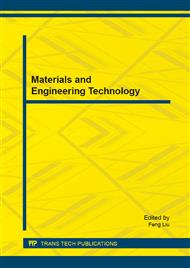[1]
M. Younis, K. Akkaya, Strategies and Techniques for Node Placement in Wireless Sensor Networks: A Survey, Ad Hoc Networks 6(4) (2008) 621-655.
DOI: 10.1016/j.adhoc.2007.05.003
Google Scholar
[2]
V.P. Mhatre, D. Kofman, N. Shroff, A Minimum Cost Heterogeneous Sensor Network with a Lifetime Constraint, IEEE Transactions on Mobile Computing 4 (1) (2005) 4-15.
DOI: 10.1109/tmc.2005.2
Google Scholar
[3]
Q. Wang, K. Xu, G. Takahara , H. Hassanein, Device Placement for Heterogeneous Wireless Sensor Networks: Minimum Cost with Lifetime Constraints, IEEE Transactions on Wireless Communications 6 (7) (2007) 2444-2453.
DOI: 10.1109/twc.2007.05357
Google Scholar
[4]
Y. Chen, C. Chuan, Q. Zhao, Sensor Placement for Maximizing Lifetime per Unit Cost in Wireless Sensor Networks, in: Proceedings of IEEE Military Communication Conference (2005) 1097- 1102.
DOI: 10.1109/milcom.2005.1605825
Google Scholar
[5]
B. Li, Q. Wang, Y. Yang, J. Wang, Optimal Distribution of Redundant Sensor Nodes for Wireless Sensor Networks, in: Proceedings of IEEE International Conference on Industrial Informatics, Singapore(2006) 985-989.
DOI: 10.1109/indin.2006.275731
Google Scholar
[6]
S. Halder, A. Ghosal, S. Sur, A. Dan, S. DasBit, A Lifetime Enhancing Node Deployment Strategy in WSN, in: Proceeding of FGIT(2009), LNCS 5899 295-307.
Google Scholar
[7]
S. Halder, A. Ghosal, S. DasBit, A Pre-Determined Node Deployment Strategy to Prolong Network Lifetime in Wireless Sensor Network, Computer Communication 34 (11) (2006) 1294- 1306.
DOI: 10.1016/j.comcom.2011.01.004
Google Scholar
[8]
H. Zhang, J.C. Hou, Maintaining Sensing Coverage and Connectivity in Large Sensor Networks, Wireless Ad Hoc and Sensor Networks 1 (1) (2005) 89-124.
DOI: 10.1201/9780203323687.ch28
Google Scholar
[9]
M.L. Sichitiu, R. Dutta, Benefits of Multiple Battery Levels for the Lifetime of Large Wireless Sensor Networks, Lecture Notes in Computer Science 3462 (2005) 1440-1444.
DOI: 10.1007/11422778_133
Google Scholar
[10]
H.Y. Long, Y.P. Liu, Y.Q. Wang, Robert P. Dick, Huazhong Yang, Battery Allocation for Wireless Sensor Network Lifetime Maximization under Cost Constraints, in: IEEE/ACM International Conference on Computer-Aided Design Digest, San Jose, California, USA, (2009).
DOI: 10.1145/1687399.1687529
Google Scholar
[11]
Y.P. Liu, Y.Q. Wang, H.Y. Long, Lifetime-Aware Battery Allocation for Wireless Sensor Network under Cost Constraints, IEICE Transactions on Communications E95B (5) (2012) 1651-1660.
DOI: 10.1587/transcom.e95.b.1651
Google Scholar


